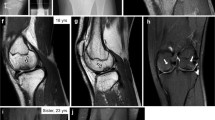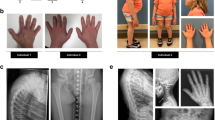Abstract
Altered growth and function of synoviocytes, the intimal cells which line joint cavities and tendon sheaths, occur in a number of skeletal diseases1. Hyperplasia of synoviocytes is found in both rheumatoid arthritis and osteoarthritis, despite differences in the underlying aetiologies of the two disorders. We have studied the autosomal recessive disorder camptodactyly-arthropathy-coxa vara-pericarditis syndrome (CACP; MIM 208250) to identify biological pathways that lead to synoviocyte hyperplasia, the principal pathological feature of this syndrome. Using a positional-candidate approach, we identified mutations in a gene (CACP) encoding a secreted proteoglycan as the cause of CACP. The CACP protein, which has previously been identified as both 'megakaryocyte stimulating factor precursor'2 and 'superficial zone protein'3, contains domains that have homology to somatomedin B, heparin-binding proteins, mucins and haemopexins. In addition to expression in joint synovium and cartilage, CACP is expressed in non-skeletal tissues including liver and pericardium. The similarity of CACP sequence to that of other protein families and the expression of CACP in non-skeletal tissues suggest it may have diverse biological activities.
This is a preview of subscription content, access via your institution
Access options
Subscribe to this journal
Receive 12 print issues and online access
$209.00 per year
only $17.42 per issue
Buy this article
- Purchase on Springer Link
- Instant access to full article PDF
Prices may be subject to local taxes which are calculated during checkout



Similar content being viewed by others
Accession codes
References
Soren, A. Histodiagnosis and Clinical Correlation of Rheumatoid and Other Synovitis (J.B. Lippincott, Philadelphia, 1978).
Turner, K.J. et al. Purification, biochemical characterization, and cloning of a novel megakaryocyte stimulating factor that has megakaryocyte colony stimulating activity. Blood 78 (suppl. 1), 279 (1991).
Flannery, C.R. et al. Articular cartilage superficial zone protein (SZP) is homologous to megakaryocyte stimulating factor precursor and is a multifunctional proteoglycan with potential growth-promoting, cytoprotective, and lubricating properties in cartilage metabolism. Biochem. Biophys. Res. Commun. 254, 535–541 (1999).
Levick, J.R. Blood flow and mass transport in synovial joints. in >Handbook of Physiology Vol. IV, Microcirculation, Part 2 (eds Renkins, E.M. & Michel, C.C.) 917–947 (American Physiological Society, Bethesda, 1984).
Harris, E.D. Mechanisms of disease: rheumatoid arthritis-pathophysiology and implications for therapy. N. Engl. J. Med. 322, 1277– 1289 (1990).
Wallis, W.J., Simkin, P.A. & Nelp, W.B. Low synovial clearance of iodide provides evidence of hypoperfusion in chronic rheumatoid synovitis. Arthritis Rheum. 28,1096–1104 ( 1985).
Case, J.P. et al. Transin/stromelysin expression in rheumatoid synovium. A transformation-associated metalloproteinase secreted by phenotypically invasive synoviocytes. Am. J. Pathol. 135, 1055–1064 (1989).
Firestein, G.S. Invasive fibroblast-like synoviocytes in rheumatoid arthritis. Passive responders or transformed aggressors? Arthritis Rheum. 39, 1781–1790 (1996).
Athreya, B.H. & Schumacher, H.R. Pathologic features of a familial arthropathy associated with congenital flexion contractures of the fingers. Arthritis Rheum. 21, 429– 437 (1978).
Ochi, T., Iwase, R., Okabe, N., Fink, C.W. & Ono, K. The pathology of the involved tendons in patients with familial arthropathy and congenital camptodactyly. Arthritis Rheum. 26, 896–900 (1983).
Martinez-Lavin, M. et al. A familial syndrome of pericarditis, arthritis, and camptodactyly. N. Engl. J. Med. 309, 224– 225 (1983).
Verma, U.N. et al. A syndrome of fibrosing pleuritis, pericarditis, and synovitis with infantile contractures of fingers and toes in 2 sisters: "familial fibrosing serositis". J. Rheumatol. 22, 2349– 2355 (1995).
McRorie, E.R., Wright, R.A., Errington, M.L. & Luqmani, R.A. Rheumatoid constrictive pericarditis. Br. J. Rheumatol. 36, 100–103 (1997).
Graham, W.R. Rheumatoid pleuritis. Southern Med. J. 83, 973–975 (1990).
Bahabri, S.A. et al. The camptodactyly-arthropathy-coxa vara-pericarditis syndrome. Clinical features and genetic mapping to human chromosome 1. Arthritis Rheum. 41, 730–735 ( 1998).
Ferlanti, E.S., Ryan, J.F., Makalowska, I. & Baxevanis, A.D. WebBLAST 2.0: an integrated solution for organizing and analyzing sequence data. Bioinformatic 15, 422– 423 (1999).
Schumacher, B.L. et al. A novel proteoglycan synthesized and secreted by chondrocytes of the superficial zone of articular cartilage. Arch. Biochem. Biophys. 311, 144–152 ( 1994).
Schumacher, B.L. et al. Immunodetection and partial cDNA sequence of the proteoglycan, superficial zone protein, synthesized by cells lining synovial joints. J. Orthop. Res. 17, 110–120 (1999).
Merberg, D.M. et al. in Biology of Vitronectins and Their Receptors (eds Preissner, K.T., Rosenblatt, S., Kost, C., Wegerhoff, J. & Mosher, D.F.) 45–52 (Elsevier Science, Amsterdam, 1993).
Woods, A. & Couchman, J.R. Syndecans: synergistic activators of cell adhesion. Trends Cell Biol. 8, 189 –192 (1998).
Ponta, H., Wainwright, D. & Herrlich, P. The CD44 protein family. Int. J. Biochem. Cell Biol. 30, 299–305 ( 1998).
Nishiyama, A. et al. The primary sturcture of NG2, a novel membrane-spanning proteoglycan. J. Cell Biol. 114, 359– 371 (1991).
David, G. Biology and pathology of the pericellular heparan sulphate proteoglycans. Biochem. Soc. Trans. 19, 816– 820 (1991).
Iozzo, R.V. Matrix proteoglycans: from molecular design to cellular function. Annu. Rev. Biochem. 67, 609–652 (1998).
Bulutlar, G., Yazici, H., Ozdogan, H. & Schreuder, I. A familial syndrome of pericarditis, arthritis, camptodactyly, and coxa vara. Arthritis Rheum. 29, 436–438 ( 1986).
Neitzel, H. A routine method for the establishment of permanent growing lymphoblastoid cell lines. Hum. Genet. 73, 320– 326 (1986).
Sambrook, J., Fritsch, E.F. & Maniatis, T. Molecular Cloning: A Laboratory Manual (Cold Spring Harbor Laboratory Press, Plainville, New York, 1989).
Ewing, B., Hillier, L., Wendl, M.C. & Green, P. Base-calling of automated sequencer traces using PHRED. Genome Res. 8, 175–185 (1998).
Gordon, D., Abajian, C. & Green, P. CONSED: a graphical tool for sequence finishing. Genome Res. 8, 195–202 ( 1998).
Powell, S.M. et al. Molecular diagnosis of familial adenomatous polyposis. N. Engl. J. Med. 329,1982–1987 (1993).
van der Luijt, R. et al. Rapid detection of translation-terminating mutations at the adenomatous polyposis coli (APC) gene by direct protein truncation test. Genomics 20, 1–4 ( 1994).
Acknowledgements
We thank the families for participating and S. Gregory, B. Lamb, E. Eichler and members of their labs, J. Ivanovich, K. Gustashaw, J. Preston, C. Williams, H. Kuivaniemi, G. Tromp, A. Superti-Furga, B. Athreya and I. Simsek for sharing their clinical and scientific expertise. This work was supported by a Biomedical Research Grant from the Arthritis Foundation and NIH grant AR43827 (both to M.L.W.).
Author information
Authors and Affiliations
Corresponding authors
Supplementary information
Rights and permissions
About this article
Cite this article
Marcelino, J., Carpten, J., Suwairi, W. et al. CACP, encoding a secreted proteoglycan, is mutated in camptodactyly-arthropathy-coxa vara-pericarditis syndrome. Nat Genet 23, 319–322 (1999). https://doi.org/10.1038/15496
Received:
Accepted:
Issue Date:
DOI: https://doi.org/10.1038/15496
This article is cited by
-
A novel mutation in the proteoglycan 4 gene causing CACP syndrome: two sisters report
Pediatric Rheumatology (2023)
-
Osteoarthritis: pathogenic signaling pathways and therapeutic targets
Signal Transduction and Targeted Therapy (2023)
-
The superficial zone of articular cartilage
Inflammation and Regeneration (2022)
-
Induction of iPSC-derived Prg4-positive cells with characteristics of superficial zone chondrocytes and fibroblast-like synovial cells
BMC Molecular and Cell Biology (2022)
-
Monogenic disorders as mimics of juvenile idiopathic arthritis
Pediatric Rheumatology (2022)



